I’m so lucky to live near Washington, DC. A couple of months ago I heard that The Smithsonian Institution was offering an all day lecture on The Regency World of Jane Austen by Bonita Billman, an Art Historican from Georgetown University. The lecture was scheduled for two days after my Mills & Boon book #5 was due, so the timing was perfect. I decided to indulge myself (the museums in DC are free, but the lecture was a little pricey) and sign up.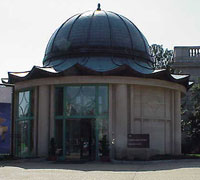
The lecture was held in the Ripley Center, the entrance of which is between the Freer Gallery and the Museum of African Art (We’re full of museums in DC). The Center is underground, and the lecture hall is a very comfortable room with theatre seats.
Ms. Billman showed the Regency World of Jane Austen through visual images, slides of the art of the time period, but also photography of the architecture, decorative arts, and fashions. She used the “social Regency” definition (1790-1830) rather than “political Regency” (1811-1821), when the Prince was Regent. I think she slipped a little into the Georgian period, but that was okay. The day was divided into four lectures: The Personalities in Jane Austen’s World; Regency Portraiture; Late Georgian Architecture; and Daily Life, Social Customs, Interior Design, and Fashion.
Billman showed the people of the Regency through their portraits, which was great fun.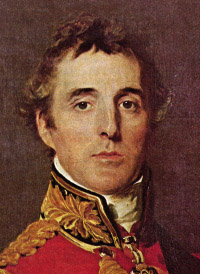 The Prince Regent, Mrs. Fitzpatrick, Beau Brummell, Jane (of course), Byron, Princess Caroline, and Princess Charlotte–and my hero, The Duke of Wellington.
The Prince Regent, Mrs. Fitzpatrick, Beau Brummell, Jane (of course), Byron, Princess Caroline, and Princess Charlotte–and my hero, The Duke of Wellington.
Next Billman talked about the portrait artists of the time: Thomas Lawrence, Thomas Gainsborough, Joshua Reynolds, George Romney, and some lesser known ones: Hoppner, Beechey, Raeburn–even Stubbs, who is best known for his horses. My favorite was when she showed slide after slide of miniatures, small portraits to keep in one’s pocket.
Cosway was a name I had not known before the lecture. I love miniatures and hope some day to find one I can afford.
The next lecture was about the architecture. She basically just showed classical and gothic architecture–and, of course, the Pavilion.
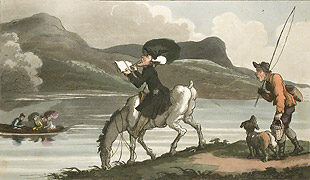
She talked about William Gilpin, who toured the areas of natural beauty in the British Isles and whose home tour was satirized in Rowlandson’s Tours of Dr. Syntax.
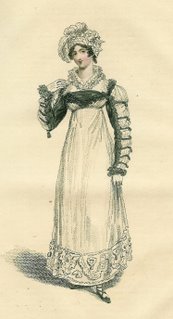 Then last of all slide after slide of furniture, porcelain (not enough of that), interior design, and clothing.
Then last of all slide after slide of furniture, porcelain (not enough of that), interior design, and clothing.
I did not expect to learn new things, but I did. I did not know about Cosway, the miniaturist. I did not know about Gilpin or the Picturesque movement, but my interest was held throughout the whole day.
Another thing about it, I usually go places like this with a friend, but I wound up going alone and, actually, that was good for me. In a way it became more of a respite for me and I could more easily immerse myself in the time period and in the art. It was a day very well spent!
Cheers!
Diane

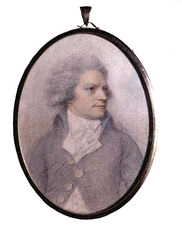

Your day sounds wonderful!! An artist’s date, from Julia Cameron’s The Artist’s Way. I try to keep my date every week, for at least two hours on my own doing something new and different. Fills the well for my own creativity and is a lovely way to experience new things.
Hope it gave you lots of great ideas for your next story. Can’t wait!
Hey, Terry, it was like an artist’s date, wasn’t it?
I have The Artist’s Way – haven’t done it yet, though, but the artist’s date is a great concept.
Ooh, Diane, I wish I lived closer to a city where such things are available!
Re the Artist’s Way, I am good about the journaling but sometimes don’t manage the artist’s dates. But I agree they are an important part of the process!
What a fascinating lecture, Diane! I wish we had things like that in my area. But we are having a “Napoleon” exhibit starting in February that I’m really looking forward to (hoping there will be some lectures in conjunction with it)
What a delightful day you had! And I’m so looking forward to seeing bits and pieces of it show up in your tales!
Sounds lovely! Wish I’d been there!
Ancient gossip tidbit — Thomas Jefferson was (at one point) in love with Cosway’s wife, who was also an artist… 🙂
I’ve seen some miniatures (the Huntington Art Galleries nearby me have a LOT) and they’re really amazing. They were huge then, and we hear so much less about them than anything else!
(Okay, I mean HUGE in a metaphorical sense.)
Cara
What a fabulous treat post-book, Diane! Thanks for sharing those pictures.
Candice Hern has many pictures of miniatures and fashion plates from her own personal collection up on her site.
Is The Artist’s Way like Vogler’s book about characters?
Apologies to the Riskies for being so scarce on this site this past week. I’m just getting back into all the posts of last week and commenting.
Keira,
The Artists Way is really more like a way to increase creativity, rather than being specific about how to craft stories. It could work for any type of art. (chime in Terry and Elena- you probably know more.)
Amanda, do you remember seeing Napoleon’s death mask at the British Museum?
Cara, she did include that tidbit about Jefferson and Cosway’s wife. I love the miniatures. There is something so personal about them.
Judy T, I don’t know yet how I’ll use the day in my writing, but it sure was great to do.
Diane, thanks much for the clarification! I’ve added it to my book list.
Sounds like a lovely day at the The Smithsonian Institution. I love portraits and historical information too.
Also a big belated Congratulations on Mills & Boon book #5 being sent in!!
Also, you and Amanda looked beautiful in your Regency gowns! 🙂
I didn’t go to this because I was finishing a book, tho I thought it looked very tempting. We’re lucky to have Diane to give us a report!
Janet
I’ll talk a little about The Artist’s Way on Wednesday, when I blog about my writer’s bookshelf. Well, not everything on it, just a few of my favorites. 🙂
That sounded so great!! Sure wish I lived closer to some of this stuff! LOL 🙂 I remember seeing in the local papers I guess during the summer that over the past couple months there were a couple of great sounding lectures in I guess the Metropolitan Museum of Art Regency related. Sigh. . . For a person who doesn’t drive and has no money, NYC even at 30 miles or so is still too far. LOL 🙂 But thanks for sharing so we can live through you!!
Lois
Thanks so much, Elena!
Lois,
One of the reasons I love the internet is that you can really see anything and go anywhere. You can look at all the art, like look here:
http://www.npg.org.uk/live/romnweb.asp
This is the National Portrait Gallery site and its a goldmine!
Nice post. I wanted to attend but life intruded. It’s wonderful living within striking distance of D.C.
Ms. Place,
There is a Constable exhibit at the National Gallery of Art in DC that will be there until the end of Dec, I think. I’m going next weekend, I hope!
(Constable was a landscape artist in the time period)
Diane,
I love the Smithsonian! When I was in college I used to work in DC in the summer…I still get out there once in a while, but I never have much time for sightseeing, alas.
I’ve never read The Artist’s Way, but I gather that the artist’s date is something recommended there? What is it…a special trip to spur creativity, or something like that?
Todd-who-wonders-if-when-a-non-artist-goes-on-an-artist’s-date-he-is-expected-to-pay-for-dinner
I remember the death mask, Diane! I also remember that nasty Victorian necklace made of dried hummingbirds, yuck (no wonder I’m not terribly interested in the Victorian period!). Oh, and the big, nekkid Napoleon statue at Apsley House! 🙂
Billman showed a slide of the Nekkid Napoleon statue during the lecture and I had to smile, remembering standing “right there.”
I know I’m a few days behind replying to this (for some reason I can’t sign in or see the word verification on my computer at work), but I really did want to say that this sounded amazing. I wish I’d known about it in advance since I’m only a hop, skip and jump up 270 from DC. I live in Frederick. If you ever need a partner-in-crime for a lecture or exhibition or what have you, drop me a line. 😀 (linda at lindataggart dot com)
I’m glad you had fun, though! Aren’t those “me” days the best?
Arrrggh! Mina! I would have loved to have had your company. Forget what I said about being alone. I would much have preferred to share the experience with someone.
I hope I remember your willingness to come. I’ll keep my eyes posted for something else.
Diane, speaking of events in the DC metro area, you might be interested in this. An email group called WritingRegency that I am on is setting up teas at our favorite tea places around the DC metro area. The first will be in January here in Frederick at Cafe Anglais (date tbd). One of the other people dreaming this up with me might get us a tea at the British embassy, even.
If you’re interested (and anyone else local to the DC metro area, too) email me at linda (at) lindataggart (dot) com. 🙂